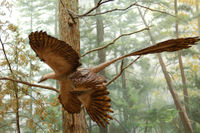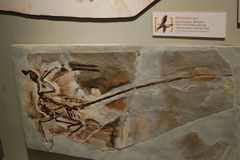Microraptor
2007 Schools Wikipedia Selection. Related subjects: Dinosaurs
| iMicroraptor |
||||||||||||||||||||
|---|---|---|---|---|---|---|---|---|---|---|---|---|---|---|---|---|---|---|---|---|
 Model of Microraptor at American Museum of Natural History, New York City
|
||||||||||||||||||||
| Scientific classification | ||||||||||||||||||||
|
||||||||||||||||||||
|
|
||||||||||||||||||||
|
Microraptor ("small thief") was a genus of small, dromaeosaurid dinosaur from the Lower Cretaceous Period ( Barremian stage), 130-125.5 million years ago. Like Archaeopteryx, it demonstrates the close evolutionary relationship between birds and dinosaurs, as it had long pennaceous feathers on its limbs and tail. Two species have been named, M. zhaoianus and M. gui. It has recently been suggested that all of the specimens belong to a single species, which is properly called M. zhaoianus. Cryptovolans, another four-winged dromaeosaur, may also be a species of Microraptor.
Description
Microraptor was about 77cm (2.5ft) long from its nose to the tip of its tail. Its body had a thick covering of feathers, with a diamond-shaped fan on the end of the tail (possibly for added stability during flight). Some specimens demonstrate a raised feather "crest" on the head, similar to some modern birds, like the Pileated Woodpecker. Bands of dark and light present on some specimens may indicate colour patterns present in life.
Wings
Like its close relative Cryptovolans (possibly a junior synonym of Microraptor), Microraptor had two sets of wings, on both its fore- and hind legs. Close studies of the Berlin specimen of the primitive bird Archaeopteryx show that it too, had flight feathers on its hind legs, albeit shortened. Many scientists now think that all basal avians had feathers on their hind legs and that they were used like the tail feathers of present birds, for maintaining balance and changing direction in the air. Sankar Chatterjee determined in 2005 that, in order for the creature to fly, the wings must have been split-level (like a biplane) and not overlayed (like a dragonfly). It has been proposed by Chinese scientists that the animal glided, rather than flew properly, although the presence of asymmetrical feathers (a characteristic normally seen only in flying birds) on both fore and hind wings may indicate at least rudimentary powered flight (Xu et al, 2003).
Naming
The naming of Microraptor is controversial, because of the unusual circumstances of its first description. The first specimen to be described was part of a chimeric specimen — a fraud assembled from multiple specimens in China and smuggled to the USA for sale. After the fraud was revealed by Xu Xing of Beijing's Institute of Vertebrate Paleontology and Paleoanthropology, Storrs L. Olson, curator of birds in the National Museum of Natural History of the Smithsonian Institution, published a description of the tail in an obscure journal, giving it the name Archaeoraptor liaoningensis in an attempt to remove the name from the paleornithological record by assigning it to the part least likely to be a bird. However, Xu had discovered the remainder of the specimen from which the tail had been taken and published a description of it later that year, giving it the name Microraptor zhaoianus.
Since the two names designate the same individual as the type specimen, Microraptor zhaoianus is a junior objective synonym of Archaeoraptor liaoningensis and the latter, if valid, has priority. So, according to some interpretations of the International Code of Zoological Nomenclature, the valid name for this dinosaur probably is Archaeoraptor liaoningensis Olson 2000. However, there is some doubt whether Olson in fact succeeded in meeting all the formal requirements for establishing a new taxon.
Most paleontologists are unwilling to use the name Archaeoraptor regardless of the precise legal status of the name. This is firstly because that name is strongly associated with the fraud and the National Geographic scandal and secondly because they view Olson's use of the name as attempted nomenclatural sabotage and do not want to support it. The name Microraptor zhaoianus Xu et al., 2000 has therefore almost attained universal currency.
Species list
So far, six virtually complete skeletons of Microraptor have been found in Liaoning, China in 2001 and 2002.
- Family: Dromaeosauridae
- Subamily: Microraptoria
- Genus: Microraptor
- Microraptor zhaoianus
- Microraptor gui
- Genus: Microraptor
- Subamily: Microraptoria
Note: Cryptovolans pauli, which has the same four-wing body plan as M. gui, may also be a species of Microraptor. Senter et al. 2004 found that M. zhaoianus, M. gui, and C. pauli are all the same species (M. zhaoianus).
Microraptor in culture
The Microraptor featured prominently in the third episode of Prehistoric Park. They were shown as gliding dinosaurs that were closely related to birds. They flocked down to feast on worms and insects that were bought to the surface by Titanosaurus' footprints.
